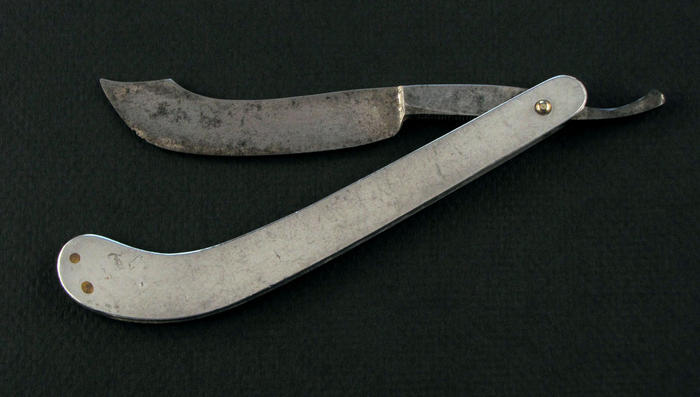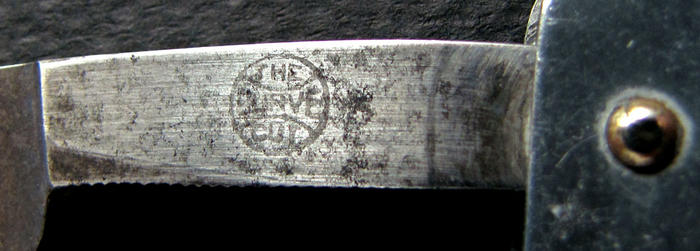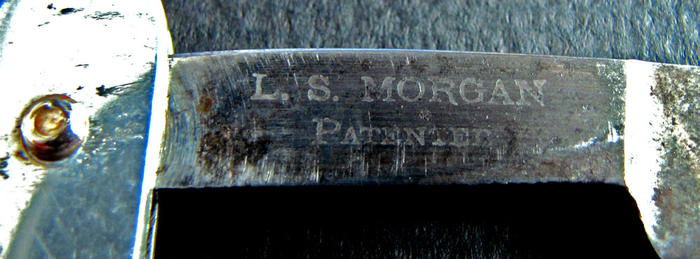Results 1 to 6 of 6
-
02-13-2015, 08:45 PM #1
 A Brief History of L. S. Morgan and The Curve Cut Razor
A Brief History of L. S. Morgan and The Curve Cut Razor
Lingreon "Lingue" Selby Morgan (1858-1931) was a farm and ranch hand who moonlighted as a small time inventor/entrepreneur. It was in this second role that he became responsible for an odd little footnote in razor history: The Curve Cut razor.



(You can see pics of a nicer example in Voidmonster's Three Curiosities thread).
Born January 27, 1858 in Kentucky, Morgan eventually moved to South Dakota and from there to Kendall, Kansas where in the late 19th and early 20th centuries he worked as the manager of the Lombard Ranch. While holding this position he was awarded at least three separate patents.
Morgan’s first two patents (patent #620,950 and patent #643,332) involved fences. The first was filed June 26, 1898 and awarded March 14, 1899. The second was filed July 11, 1899 and awarded February 13, 1900.
His third patent (patent # 779,233)—the one we’re most interested in—was for the Curve Cut Razor. It was filed August 29, 1904 and was awarded January 3, 1905.
In the patent, Morgan lays out what he believes are the advantages of this particular blade shape:
By reason of the peculiar formation of the cutting edge of the blade a more perfect shearing action is effected on the beard during the act of shaving, for thereason that during a straight pull on the blade over the face a running cut is producedthat is, the cutting edge of the blade travels or constantly changes, as it were, in the longitudinal direction of the blade, thereby effecting a more perfect and safe cutting of the beard in the hollow places of the face and neck, and, furthermore, since the curvature of the cutting edge terminates in an abrupt circular line ending at the small protuberance or toe projection in the forward end of the blade can be the more freely rocked during the operation of shaving and which also permits the blade being handled in such manner that the hand will not throw a shadow over that part of the face being shaved, especially while trimming the face above the ear.
In his later years Morgan moved with his wife Lucille to Golden City, Missouri where he passed away on January 16, 1931.
Due to the fact that this seems to be a rather rare razor, my guess is that the pattern was not manufactured in great numbers or over any extended period of time. It most likely dates to within a few years of the patent. It may be noteworthy that the example in my collection didn’t make it far from Kansas. It came out of an estate in Hastings, Nebraska. Perhaps Morgan couldn’t broker a deal for the widespread distribution of his product.Last edited by Hanlon; 02-13-2015 at 09:02 PM. Reason: adding info I forgot
-
The Following 13 Users Say Thank You to Hanlon For This Useful Post:
-
02-14-2015, 01:07 AM #2Junior Member

- Join Date
- Jul 2014
- Location
- In the middle of the Pacific
- Posts
- 29
Thanked: 10
It looks like it probably would be a great shaver for the neck hollows. He should have reached out to Crown & Sword. Imagine that blade with the Crown & Sword stamp on the tang and the blade etched "Scimitar". Would be kind of cool.
Neat posting. Reminds us all to keep our eyes open as there are still pieces of history lurking in small town America.
-
02-14-2015, 01:24 AM #3(John Ayers in SRP Facebook Group)


- Join Date
- May 2010
- Location
- Lafayette, LA
- Posts
- 1,542
Thanked: 270

Straight razor shaver and loving it!40-year survivor of electric and multiblade razors
-
02-14-2015, 03:56 AM #4

Those are all VERY INTERESTING!!!!!!!!!!!!!!!
-
02-14-2015, 04:00 AM #5

I love smilers. He certainly did not invent them, but his example looks scary. Don't reckon he got rich from it.
Neat rarity and fine thread! Love that history! "Don't be stubborn. You are missing out."
"Don't be stubborn. You are missing out."
I rest my case.
-
02-14-2015, 05:12 AM #6

Glad you all are liking the history. This is probably the most luck I've had researching the make of a particular razor. Usually it seems I can't find something like a few key dates.
I really like the looks of this razor - the scimitar shape is so striking - but I don't know about the practicality of the point. It seems like that long curved edge would make it really easy to nick your nose or ear. Unless you pretty much only used the curved portion for shaving and mostly ignored the long flat-ish part of the blade.
Can't say I'm surprised L. S. Morgan's design didn't catch on.


 13Likes
13Likes
 LinkBack URL
LinkBack URL About LinkBacks
About LinkBacks






 Reply With Quote
Reply With Quote




